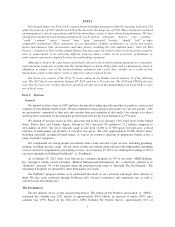Petsmart 2011 Annual Report Download - page 21
Download and view the complete annual report
Please find page 21 of the 2011 Petsmart annual report below. You can navigate through the pages in the report by either clicking on the pages listed below, or by using the keyword search tool below to find specific information within the annual report.Failure to successfully manage our inventory could harm our business.
We are exposed to inventory risks that may adversely affect our operating results as a result of seasonality,
new product launches, changes in customer preferences or demand and consumer spending patterns with respect
to our products. We endeavor to accurately predict these trends and avoid overstocking or under stocking prod-
ucts that we sell. Demand for products, however, can change between the time inventory is ordered and the date
of sale. In addition, when we begin selling a new product, it may be difficult to establish vendor relationships,
determine appropriate product selection, and accurately forecast demand. We carry a broad selection of certain
products and we may be unable to sell products in sufficient quantities or during the relevant selling seasons. Any
one of the inventory risk factors set forth above may adversely affect our business and financial results.
If our information systems fail to perform as designed or are interrupted for a significant period of time, our
business could be harmed.
The efficient operation of our business is dependent on our information systems. In particular, we rely on
our information systems to effectively manage our financial and operational data, process payroll, manage the
supply chain and to maintain our in-stock positions. We possess disaster recovery capabilities for our key
information systems, and take measures intended to prevent security breaches and computer viruses. However,
the failure of our information systems to perform as designed, due to failure to manage disasters, security
breaches, computer viruses or any other interruption of our information systems for a significant period of time
could disrupt our business.
We continue to invest in our information systems. Enhancement to or replacement of our major financial or
operational information systems could result in disruption of normal operating processes and procedures and
have a significant impact on our ability to conduct our core business operations. We can make no assurances that
the costs of enhancement to or replacement of our information systems will not exceed estimates, that the sys-
tems will be implemented without material disruption, or that the systems will be as beneficial as predicted. If
any of these events occur, our results of operations could be harmed.
If we fail to protect the integrity and security of customer and associate information, our business could be
adversely impacted.
The increasing costs associated with the implementation and on-going operation of our information security
systems, such as increased investment in technology, the costs of compliance with privacy and information
security laws, and costs resulting from potential data loss, could adversely impact our business. We also routinely
possess sensitive customer and associate information and, while we have taken reasonable and appropriate steps
to protect that information from security breaches, data loss and computer viruses, if our security procedures and
controls were compromised, unintentionally or through cyber-attacks, it could harm our business, consumer
confidence, reputation, operating results and financial condition, result in litigation and may increase the costs we
incur to protect against such information security breaches.
The disruption of the relationship with or the loss of any of our key vendors, including our vendors with whom
we have exclusive relationships, a decision by our vendors to make their products available in supermarkets or
through warehouse clubs and other mass and retail merchandisers, the inability of our vendors to provide
quality products in a timely or cost-effective manner, the availability of generic products, or risks associated
with the suppliers from whom products are sourced, all could harm our business.
Sales of premium pet food for dogs and cats comprise a significant portion of our net sales. Currently, most
major vendors of premium pet food do not permit their products to be sold in supermarkets, warehouse clubs, or
through other mass and retail merchandisers. If any premium pet food or pet supply vendor were to make its
products available in supermarkets, warehouse clubs and other mass or retail merchandisers, our business could
be harmed. In addition, if the grocery brands currently available to such retailers were to gain market share at the
expense of the premium brands sold only through specialty pet food and pet supply outlets, our business could be
harmed.
We purchase a substantial amount of pet supplies from a number of vendors with limited supply capa-
bilities, and two of our largest vendors account for a material amount of products sold. We can make no assur-
11
























